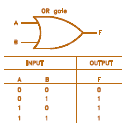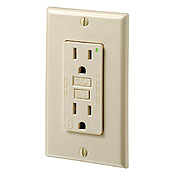Technical Engineering Dictionary
"A"
"B"
"C",
"D",
"E",
"F",
"G",
"H",
"I",
"J",
"K",
"L",
"M",
"N",
"O",
"P",
"Q",
"R",
"S",
"T",
"U",
"V",
"W",
"X",
"Y",
"Z"
'O' to 'On', 'Op' to 'Oq', 'Or' to 'Oz'
Order-Wire Circuit. A circuit between operators used for operations control and coordination.
OR Gate. A gate that performs the logic OR function. It produces an output 1 whenever any or all of its
inputs is/are 1. Glue Logic
Origin. The point on a graph where the vertical and horizontal axes cross each other.
"O" Ring. A doughnut-shaped ring of rubber used as a seal around the periphery of the mating insulator interface of cylindrical connectors.
ORing. When two circuits are ORed together so that if one fails the other circuit takes over, as in diode ORing.
Oscillate. To repeat a cycle.
Oscillation. A sustained condition normally at a particular voltage and frequency.
Oscillator. A circuit that produces a repetitive electronic signal, as in a Periodic Waveform. An oscillator is a non-rotating device that produces alternating current. The frequency is determined by the characteristics of the device. |
 Colpitts Osc |
An electronic circuit designed to produce an ideally stable alternating voltage or current. Oscillator manufacturers.
Oscilloscope. An analog or digital instrument used to plot voltage over time, with voltage being the y axis and time being the x axis. |
 Oscilloscope |
Outage. Loss of signal or power to a system.
Outgassing. The release of gas that has been trapped in a material of substance.
Outlet. A socket. An AC receptacle, an AC Outlet.
Outlet Strip. A part that has a number AC Outlets, normally in-line, or in a strip and is at the end of a flexible AC cord [which could also be considered an extension cord]. Refer to the graphic to the right. Also see the listing of Socket Strips Manufacturers.
Out-of-Circuit Meter. A meter that is not permanently installed in a circuit. Usually portable and
self-contained, these meters are used to check the operation of a circuit or to isolate troubles within a
circuit.
Output Amplifier. An amplifier that generates a high power output using a low power input.
Output Capacitance. The shunt capacitance at the output terminals of a device or circuit.
Output Capacitive Loading. The capacitance of a circuit being driven that is seen by the device driving the circuit. The maximum capacitance a circuit or amplifier can drive.
Output Enable. [OE] An input line used as a control signal to either allow an output to occur or to inhibit the output.
Output End. The end of a transmission line that is opposite the source; receiving end.
Output Impedance. The impedance that is presented to the load by the transmission line and its
source. The impedance of a circuit with no load present.
Output Offset Voltage. The voltage at the output terminals of a device when the input terminals are held at zero volts.
Output Power. The amount of power a component or system is designed to produce and deliver to a load.
Output Stage. The final stage of a series of amplifier stages designed to drive the system load.
Output Rating. The expression of the stated power available at the output terminals of a transmitter when connected to the normal load or its equivalent.
Output Resistance. The resistance as seen looking into the output of a device.
Overcurrent: Any current in excess of the rated current of equipment or the ampacity of a conductor.
It may result from overload, short circuit, or ground fault. A current in excess of rating
may be accommodated by certain equipment and conductors for a given set of conditions. Hence the
rules for over-current protection are specific for particular situations.
Overdamping. Greater damping than required to achieve critical damping.
Overdriven. When the input signal amplitude is increased to the point that the transistor goes into
saturation and cutoff.
Overdriven Amplifier. An amplifier stage driven into either saturation and cutoff. An amplifier with an input voltage greater than the circuit was designed for. The point at which an amplifier will no longer follow the input and become non-linear.
Overhead Bits. Extra bits added to a digital sequence which are used to control or interpret a system response.
Overflow. In digital communications, the condition that exists when the incoming data rate exceeds that which can be accommodated by a buffer, resulting in the loss of information. An arithmetic operation that results in an output that is larger than the buffer used to store the result.
Overhead Transmission Lines. High voltage AC transmission lines that carry 3-phase current, with voltages varying according to the particular grid system they belong to, ranging from 69 kv up to 765 kv.
Overload. Operation of equipment in excess of normal, full load rating, or of a conductor in excess
of rated ampacity which, when it persists for a sufficient length of time, would cause damage or
dangerous over-heating. A fault, such as a short circuit or ground fault, is not an overload. A load, placed on a device that is greater than the device or facility is capable of handling. A load greater than a driver can handle.
Overmodulation. A condition that exists when the peaks of the modulating signal are limited. The condition that prevails when the instantaneous level of the modulating signal exceeds the value necessary to produce 100% modulation of the carrier.
Override. To take control of a system or operation either manually or automatically.
Overshoot. In the transition of any parameter from one value to another, the transitory value of the parameter that exceeds the final value. An initial transient over-voltage [or over-current] that exceeds the normal steady state value. Read more on Pulse Over-Shoot.
Overstress. A condition that occurs when a higher than normal rated voltage or current induces a hot-spot temperature beyond specifications in the junction of a semiconductor or some other device.
Overtone Crystal. A particular cut of a crystal that allows it to operate at some harmonic of its fundamental frequency.
Overtone. Of a sinusoidal wave, an integral multiple of the frequency, i.e., the fundamental, of the wave, other than the fundamental itself.
Overvoltage. A voltage that exceeds the normal or expected voltage found between two conductors. A voltage that has increased above a circuits design limits. Some complex ICs contain their own over-voltage fault detection circuits.
In some cases these circuits are called Over-Voltage Protection [OVP] ICs.

Over Voltage Sense Circuit
Owen Bridge. [Owen AC Bridge] A bridge that uses capacitance and resistance to measure self-inductance.
Oxidation. Another term for rust.












